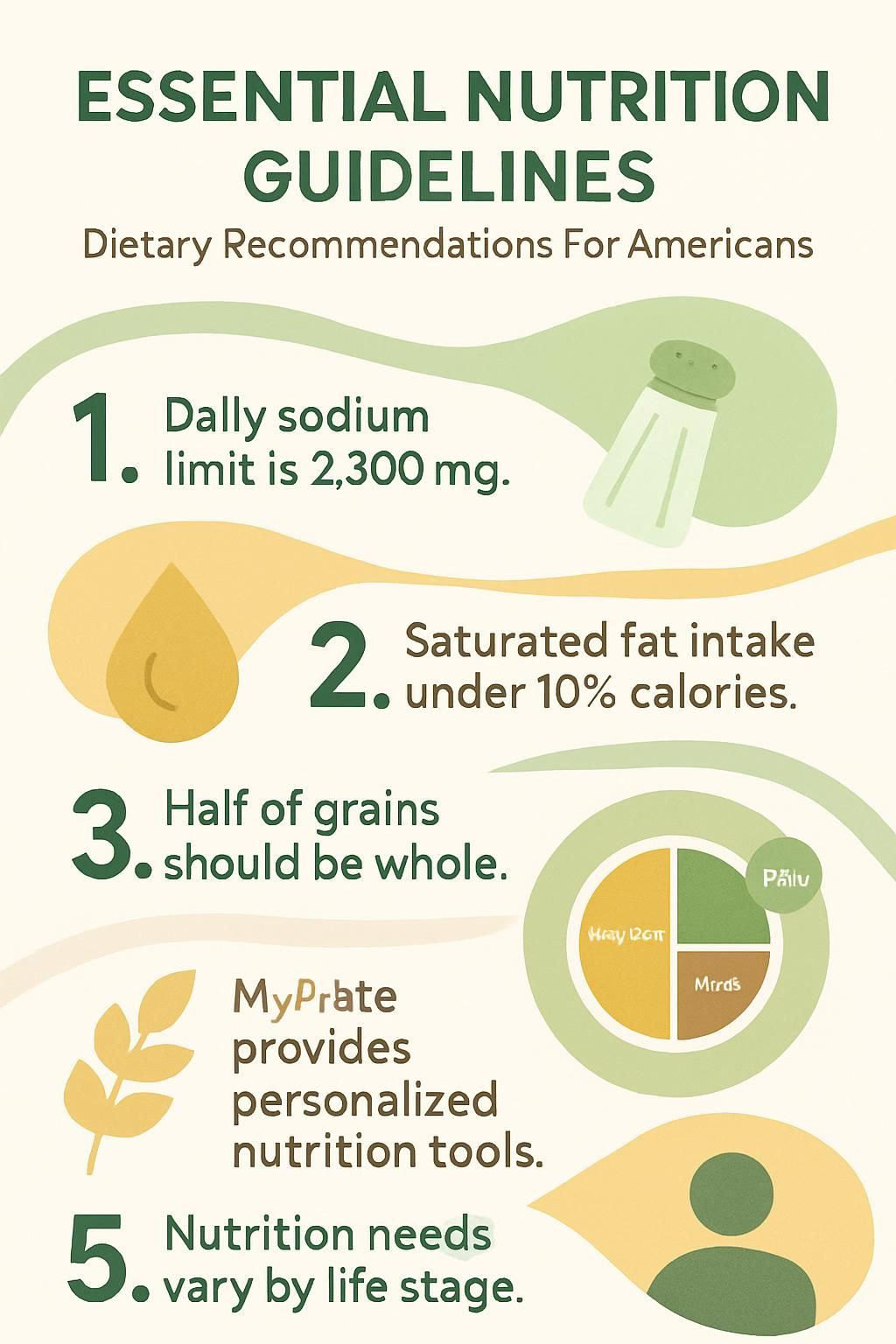Essential Nutrition Guidelines: Dietary Recommendations For Americans
Our Nutrition Assistant AI Suite will transform your body. You will lose fat, get toned, and build muscle. Gain confidence and optimal health.
You want to eat well, but the daily choices can feel unclear. The Dietary Guidelines for Americans, issued every five years by the United States Department of Agriculture and the Department of Health and Human Services, translate nutrition science into everyday steps that fit real life.
This article explains the 2020-2025 edition, defines nutrient dense foods, shows how to use MyPlate tools, and outlines what different ages need. You will also learn simple ways to plan meals on a budget and set goals you can keep. Keep reading for clear answers that help you eat healthy with confidence.
Key Takeaways
- The 2020-2025 Dietary Guidelines for Americans from USDA and HHS share updated, science-based nutrition advice for every life stage.
- Core steps include filling half your plate with fruits and vegetables, making half your grains whole, choosing lean proteins, and limiting added sugars and sodium.
- Adults should keep daily sodium under 2,300 mg and saturated fat under 10 percent of total calories.
- MyPlate tools offer personalized checklists, quizzes, recipes, shopping tips, and resources for all ages.
- Needs change by age, from infant feeding to older adult nutrition, with special attention to calcium and vitamin D later in life.

What Are Dietary Guidelines for Americans?

The Dietary Guidelines for Americans give you practical nutrition guidance that is based on research. They aim to help you make healthy eating and drinking choices at every age and stage.
What Do the Dietary Guidelines Include?
The Guidelines present clear advice on food and nutrition for people in the United States, beginning at birth and continuing through older adulthood. You can explore figures, infographics, and handouts on dietaryguidelines.gov and odphp.health.gov.
Teams from HHS and USDA review evidence to develop these materials. You will find toolkits for healthcare providers, simple guides for consumers, and background on how experts and communities contribute to the process. Professionals get discussion tools, while families get easy resources to meet nutrient needs through the lifespan.
What Are the Main Goals of These Guidelines?
The Guidelines help you meet nutrient needs, protect health across the lifespan, and lower the risk of chronic disease such as diabetes or heart disease. They are updated every five years to reflect new science and real-world needs.
Advice spans all life stages, including pregnancy and breastfeeding. The framework supports public programs and education, with a focus on affordable, nutrient dense foods and clear food labels. The aim is to help you choose options with less added sugars, saturated fat, and sodium, while getting enough protein and carbohydrates for energy.
The goal is simple: make it easier for every American to eat healthy foods and prevent illness before it starts.
Key Features of the 2020–2025 Dietary Guidelines
The 2020-2025 Dietary Guidelines serve every age group, including women who are pregnant and people managing a chronic condition. The guidance helps you align your meals with your needs and food preferences.
How Does a Life Stage Approach Work?
The life stage approach tailors advice to your current period of life, from infancy through older adulthood. It highlights nutrients that matter most during pregnancy and breastfeeding, childhood growth, adult maintenance, and healthy aging.
Resources like MyPlate and monthly featured recipes offer practical steps for different ages. Policymakers use this structure to build programs that support healthy patterns across the population. For daily choices, consumer materials show you what to eat, how much to eat, and how to adapt meals to your health goals.
What Are the Age-Specific Recommendations?
Each age group has different nutrient needs and portion sizes. Follow these summary tips to match the Guidelines to your stage of life.
- Babies, 0 to 12 months: breast milk or infant formula is the main beverage. At about six months, add small portions of solids that are nutrient dense. Include iron sources like pureed meats or fortified cereal.
- Toddlers and preschoolers, 1 to 5 years: offer all five food groups daily. Serve fruits, vegetables, whole grains, lean proteins, and dairy. Limit added sugars and salt.
- Children, 6 to 13 years: build nutrient dense meals with proper portions. MyPlate visuals help kids include fruits, vegetables, grains, proteins, and dairy at meals and snacks.
- Teenagers, 14 to 18 years: energy needs rise. Focus on whole grains, lean proteins such as grilled chicken or fish, low fat dairy or fortified soy drinks, and fewer sugar sweetened beverages.
- Adults: aim for balanced plates. Fill half with fruits and vegetables, include a moderate portion of protein foods, and choose healthy grains. Keep sodium and saturated fat in check.
- Pregnant and breastfeeding women: prioritize iron and folic acid from leafy greens and fortified cereals. Drink more fluids and include regular servings of dairy or fortified alternatives to support maternal health.
- Older adults: choose calcium rich options such as yogurt or fortified soy beverages. Portion sizes may be smaller if activity slows, but variety remains key to meeting nutrient needs.
Using MyPlate with my family showed us how needs shift over time. The Start Simple with MyPlate app sets age based goals that nudge us toward steady routines.
Why Focus on Nutrient-Dense Foods?
Nutrient dense foods pack vitamins and minerals with fewer calories, and little or no added sugars, saturated fat, or sodium. A cup of spinach delivers vitamins A and C with almost no calories, unlike many snacks that add salt or fat without nutrients.
Diets rich in nutrient dense foods are linked with lower risk of heart disease and type 2 diabetes. I swapped afternoon pastries for fruit at work, and my energy stayed steadier until dinner. Small shifts like this make a real difference over time.
The Guidelines use visuals to show why better choices lead to better health, a Food Is Medicine approach. Choosing foods that nourish your body can reduce disease risk and health costs.
Core Principles of Healthy Eating
These principles help you build meals that support your body and your goals. They also team well with regular physical activity.
Why Is It Important to Make Every Bite Count?
Each bite is a chance to get nutrients your body needs. Nutrient dense foods help you reach vitamin and mineral goals while keeping calories reasonable.
Tools like the Start Simple with MyPlate app and the MyPlate Quiz show where to improve and track your progress. Eating with purpose also helps right-size portions, which reduces added sugars, saturated fats, and sodium from processed snacks and drinks.
Over time, these small choices support strong bones, a healthy heart, and steady energy at every life stage.
How Can I Reduce Added Sugars, Saturated Fats, and Sodium?
Cutting these three nutrients supports heart health and helps manage weight and blood pressure. Start with a few simple steps.
- Check the Nutrition Facts label for added sugars and sodium. Use the 2020-2025 targets as your guide.
- Choose water or unsweetened drinks instead of soda, sports drinks, or sweet tea.
- Pick snacks like fruit, plain yogurt, or nuts instead of cookies or pastries that are high in added sugars and unhealthy fats.
- Cook at home more often so you can use less salt and butter. Simple recipes keep sodium and saturated fat lower.
- Swap processed meats like bacon or sausage for chicken breast, fish, beans, or lentils.
- Ask for sauces and dressings on the side at restaurants, since many are high in sodium and sugar.
- Season with herbs, garlic, citrus, or pepper instead of salt.
- Use educational handouts from health professionals and public agencies for smart swaps and tips.
- Try flavor boosts like lemon juice in salads instead of extra salt.
- Download resources from MyPlate.gov to help you meet evidence based limits for sugar, fat, and salt.
Sources: U.S. Department of Health and Human Services, USDA Dietary Guidelines for Americans 2020-2025, and MyPlate.gov.
How Do I Include a Variety of Food Groups in My Diet?
Balanced meals include all five MyPlate groups. Variety helps you cover your nutrient bases and keeps meals interesting.
- Use the MyPlate symbol to guide portions of fruits, vegetables, grains, protein foods, and dairy at meals.
- Fill half your plate with fruits and vegetables like berries, greens, carrots, or peppers for fiber and vitamins.
- Make at least half your grains whole, such as oatmeal, brown rice, or whole wheat bread.
- Vary protein sources across the week with lean meats, beans, nuts, poultry, seafood, or eggs.
- Choose fat free or low fat dairy, or fortified soy drinks, to get calcium without excess saturated fat.
- Rotate colors and types within each group during the week.
- Use the Start Simple app for daily reminders to meet each food group goal.
- Search MyPlate Kitchen for recipes that combine several groups into one easy dish.
- Explore USDA toolkits that add variety with simple meal planning activities.
This approach prepares you for the daily nutrient targets in the next section.
What Are Essential Daily Nutritional Requirements?
Daily nutrient needs support energy, growth, and disease prevention. Meeting them through food first is the priority.
Why Are Fruits and Vegetables Important?
Fruits and vegetables provide vitamins, minerals, and dietary fiber. The Guidelines advise filling half your plate with produce at most meals.
Different colors signal different nutrients. For example, oranges and berries bring vitamin C, while leafy greens provide folate and potassium. Regular intake is linked with lower risk of heart disease and type 2 diabetes.
MyPlate Kitchen makes it easy to add produce with simple recipes. When I added a bowl of mixed fruit to breakfast, I stayed full longer and snacked less before lunch.
What Are the Benefits of Whole Grains?
Whole grains contain fiber, B vitamins, and minerals like iron and magnesium. Fiber supports digestion and helps you feel full longer, which can help with weight control.
The Guidelines recommend at least half of your grain choices be whole. Higher whole grain intake is associated with lower risk of heart disease, type 2 diabetes, and obesity.
Try oats, brown rice, quinoa, or whole wheat pasta. I switched from sugary cereal to oatmeal, and it kept me satisfied until midday.
What Are Good Sources of Lean Proteins?
Lean proteins provide amino acids, the building blocks for muscle and tissue. Choose options that limit saturated fat.
Good picks include poultry without skin, fish such as salmon or cod, beans and peas, and small portions of nuts and seeds. Use MyPlate Kitchen to discover easy, high protein meals.
Limit red and processed meats because they often contain more sodium and saturated fat. I now add black beans to salads instead of bacon, and the flavor still satisfies.
What Are Dairy and Fortified Alternatives?
Dairy foods and fortified alternatives supply calcium and vitamin D, which support bone health. Choose low fat or fat free milk and yogurt to limit saturated fat.
If you avoid dairy, select lactose free milk or fortified soy beverages to cover calcium and vitamin D needs. My clinician suggested fortified soy milk during my teen years, and it kept my bones strong without stomach discomfort.
Include this group daily. Kids often need more during growth spurts, while adults need steady intake over time.
How Do Dietary Needs Differ for Specific Groups?
Your needs shift with age, health status, and life events. Tailoring your plan helps you get the right nutrients at the right time.
What Nutrition Is Recommended for Pregnant and Breastfeeding Women?
Pregnancy and breastfeeding raise nutrient needs for you and your baby. Focus on these key steps.
- Get folic acid every day from leafy greens and fortified cereal to help prevent birth defects.
- Increase iron with lean meat, beans, spinach, or fortified grains to support blood volume and reduce anemia risk.
- Meet calcium needs with low fat dairy or fortified alternatives for strong bones and teeth.
- Use MyPlate resources for pregnancy and breastfeeding for meal ideas and tips.
- Choose nutrient dense foods at each meal and limit added sugars, saturated fat, and sodium.
- Follow weight gain guidance from the 2020-2025 Dietary Guidelines to support healthy development.
- Drink plenty of water each day to support higher fluid needs.
- Breastfeed exclusively if possible during early months, since it supports infant nutrition and immunity.
- Review public health infographics on maternal nutrition for clear targets and checklists.
- Discuss prenatal supplements with a healthcare provider, especially folic acid and iron.
During my pregnancy, I used MyPlate tips and met with my provider to review progress. Those habits kept me on track with the recommendations.
What Are Healthy Eating Habits for Children and Adolescents?
Healthy habits in childhood set the stage for strong growth and lifelong wellness. Keep meals simple, colorful, and consistent.
- Offer nutrient dense options at meals and snacks, including fruits, vegetables, whole grains, lean proteins, and low fat dairy.
- Serve age appropriate portions to match energy needs and reduce excess intake.
- Use MyPlate visuals for kids and teens to show how a balanced plate looks.
- Limit sugary drinks. Offer water or milk instead to cut added sugars.
- Rotate snack choices to include carrots, yogurt, apples, or small trail mix portions.
- Read labels together to spot added sugars, sodium, and saturated fat.
- Cook as a family. Plan grocery lists that feature colorful produce and whole grains.
- Use national campaign materials to teach benefits of fruits and vegetables.
- Set regular meal and snack times. Do not skip breakfast, which supports focus at school.
- Choose nutrient rich snacks such as whole wheat crackers with cheese instead of chips or cookies.
What Are Dietary Needs for Older Adults?
Age related changes affect appetite, muscle mass, and bone strength. A few smart steps can make eating easier and more effective.
- Pick nutrient dense foods with fewer calories. This helps manage weight while meeting vitamin and mineral needs.
- Include lean protein at each meal to maintain muscle. Try fish, eggs, poultry, legumes, or tofu.
- Prioritize calcium and vitamin D with fortified dairy or soy options to support bones.
- Fill half your plate with fruits and vegetables for fiber and vitamins A and C.
- Reduce added sugars, saturated fat, and sodium using swaps like unsweetened yogurt and herb seasoning.
- Use MyPlate resources tailored to older adults for recipe ideas and shopping tips.
- Collect simple handouts from public health groups for easy, senior friendly recipes.
- If cooking for one, batch cook and freeze portions for quick, wholesome meals.
For more information, visit resources from USDA and the National Institutes of Health that support healthy aging.
How Should Nutrition Be Managed for Chronic Conditions?
Diet can help manage blood sugar, blood pressure, and cholesterol. A structured plan makes daily choices easier.
- Center meals on nutrient dense foods like produce, lean proteins, and whole grains.
- Limit added sugars, sodium, and saturated fat. Adults with high blood pressure should keep sodium under 2,300 mg per day.
- Adapt recipes using handouts for diabetes or heart health, including herb and spice swaps for salt.
- Work with a registered dietitian for a plan tailored to your history and lab results.
- Choose fortified dairy alternatives if you avoid lactose, making sure calcium and vitamin D needs are met.
- Use provider approved tools from USDA or CDC for step by step meal planning.
- Follow a Food Is Medicine mindset, choosing foods that improve key health markers.
- Watch portions to support weight goals, which influence blood sugar and blood pressure.
- Schedule regular check ins with your healthcare team to adjust goals as needed.
How Does Physical Activity Complement Nutrition?
Eating well and moving regularly work together like gears in a clock, each action helping the other run smoothly.
What Are the Benefits of Combining Diet and Exercise?
Healthy eating plus physical activity improves heart health, mood, and energy. It also lowers the risk of type 2 diabetes, obesity, and some cancers.
Adults who reach at least 150 minutes of moderate activity per week and follow the Guidelines often see better blood pressure and cholesterol levels, according to CDC data. Use tools from the Office of Disease Prevention and Health Promotion to track meals and movement in one place.
Many people set daily targets for steps and vegetables. Small wins build momentum, like a brisk walk after dinner and a plate half filled with produce.
What Activity Levels Are Recommended for Different Groups?
Age specific activity goals help you stay strong and independent. Match your plan to your stage of life.
- Children ages 3 to 5 should be active throughout the day. Active play supports growth and learning.
- Youth ages 6 to 17 need at least 60 minutes daily. Include aerobic, muscle strengthening, and bone strengthening moves.
- Adults ages 18 to 64 should get 150 to 300 minutes of moderate intensity activity each week, such as brisk walking or cycling.
- Adults can also meet goals with 75 to 150 minutes of vigorous activity, such as running or fast swimming.
- Do muscle strengthening exercises at least two days per week.
- Older adults ages 65 and up should follow adult targets if able, and add balance training to prevent falls.
- MyPlate resources suggest everyday ways to move more at any ability level.
- Physical Activity Guidelines handouts provide ideas like family walks or community sports.
- Everyone benefits from sitting less. Stand, stretch, and take short movement breaks during the day.
These recommendations pair well with nutritious meals for stronger health outcomes.
What Resources Help Support Healthy Eating?
Helpful tools make healthy eating easier to start and easier to maintain. Most are free and simple to use.
How Can I Use MyPlate for Guidance?
MyPlate, from the USDA, is a visual guide for building balanced meals. Use the website or mobile app to access daily checklists, age specific tips, and goal tracking.
Save recipes and cookbooks to your account, and track your MyPlate Quiz results. You can also set reminders and share progress with #WhatsOnMyPlate. Whether on your phone or computer, you can plan from anywhere.
MyPlate aligns with federal recommendations, which helps every meal count for better health.
What Are Some Budget-Friendly Healthy Eating Tips?
Eating well on a budget is possible with a bit of planning. Start small, then build a routine that fits your week.
- Plan meals for the week, then write a list to reduce impulse buys.
- Pick seasonal produce, which is usually fresher and costs less.
- Use MyPlate Kitchen recipes that focus on low cost, nutrient rich ingredients.
- Choose store brands, which often match name brand quality at a lower price.
- Buy budget friendly proteins like dried beans, lentils, eggs, canned tuna, or canned chicken.
- Compare unit prices per ounce or pound to find the best value.
- Buy whole grains like brown rice or oats in bulk to stretch meals.
- Freeze leftovers in single portions to reduce waste and save time later.
- Consider programs such as SNAP or WIC if you need help accessing healthy foods.
- Check local food banks for fresh produce and basic pantry items.
- Try monthly featured recipes on MyPlate Kitchen that highlight seasonal, affordable ingredients.
These steps protect both your wallet and your health goals.
Where Can I Find Recipes for Nutrient-Rich Meals?
Visit MyPlate Kitchen to search thousands of recipes by ingredient, meal type, or food group. Many options meet the 2020-2025 Dietary Guidelines and support different life stages.
You can also download free cookbooks and planning tools for home cooks and professionals. I tried a quick Mediterranean salad from the site, and it delivered vegetables, lean protein, and healthy fats in under 15 minutes.
With these resources, weekly meal planning becomes faster and more consistent.
How Can I Set Personal Nutrition Goals?
Specific, small goals help habits stick. Use digital tools and check-ins to keep progress moving forward.
How Do I Evaluate My Current Eating Patterns?
Start with the MyPlate Quiz to map your food choices by group. You get personal feedback and ideas for improvement based on your answers.
Use daily checklists, infographics, and guides to spot gaps. Clear visuals make it easy for families to compare current habits with the Dietary Guidelines for Americans.
How Can I Design Sustainable Dietary Changes?
Lasting change happens in small, steady steps. The 2020-2025 Guidelines encourage realistic goals that fit your life.
- Set small, specific goals with the MyPlate app. Try adding a vegetable at dinner or replacing one sugary drink with water each day.
- Track your intake for a few days to spot patterns you can improve.
- Swap in nutrient dense foods. Choose fruit over chips or whole grains over refined grains.
- Reduce added sugars, saturated fat, and sodium gradually. Use lower sodium soups or less sugar in coffee.
- Use budget tips like planning ahead and buying frozen produce when needed.
- Explore recipes that match your taste and health needs to keep meals interesting.
- Read success stories on MyPlate or USDA pages to boost motivation.
- Ask a health professional for guidance that fits your age, health, and goals.
- Review progress every few weeks. Adjust goals and celebrate wins to stay on track.
These actions make every bite count and keep your plan doable for the long run.
What Is the Role of Public Health in Nutrition?
Public health programs expand access to healthy foods and reliable nutrition education. Better access and clearer guidance help whole communities thrive.
How Is Nutrition Education Improved?
Education materials are updated every five years to reflect the Dietary Guidelines for Americans. You can find infographics, toolkits, and slides designed for clear teaching across ages and settings.
Schools use these resources in health classes. Community centers host workshops for new parents or older adults. Continuing Professional Education helps educators keep lessons current and accurate.
These efforts build practical knowledge that supports healthier choices day to day.
What Is Being Done to Combat Food Insecurity?
Federal programs such as SNAP and WIC use the Guidelines to shape benefits and access. Local efforts with schools and community centers increase availability of fruits, vegetables, whole grains, and dairy alternatives.
Many centers offer easy recipe cards based on typical pantry items. In my neighborhood, those cards helped our family plan low cost meals without losing nutrition quality.
Agencies coordinate across sectors to reach people with limited access or special health needs. This teamwork strengthens nutrition support for more households.
How Do Collaborative Efforts Improve Nutrition?
Partnerships help consistent messages spread farther, from national policy to local kitchens.
How Do Government and Health Organizations Partner?
HHS and USDA jointly develop and publish the Dietary Guidelines for Americans every five years. The Office of Disease Prevention and Health Promotion helps put the guidance into practice and raises awareness through outreach.
Scientific advisory committees review the latest research and present reports. Federal, state, and local partners then align programs to promote healthy eating. These efforts produce clear, consistent materials for communities across the United States.
What Role Do Health Professionals Play?
Dietitians, nurses, doctors, and nutritionists use the Guidelines to give evidence based advice. They rely on handouts, slides, and toolkits to teach healthy patterns and design meal plans for your goals.
Continuing education keeps their skills current. Expert feedback also shapes the next update of the Guidelines, which supports public education campaigns and school meal standards.
What’s Next for the 2025–2030 Dietary Guidelines?
Experts are reviewing new research to address current nutrition challenges. You can expect updates that reflect today’s science and community needs.
How Are Future Guidelines Developed?
Federal agencies plan years ahead. Advisory committees analyze studies, health data, and trends, then hold public meetings and invite comments.
USDA and HHS collect input from researchers, clinicians, advocacy groups, and citizens. Findings shape a detailed report that becomes the foundation for the next Guidelines. I joined a virtual session where parents discussed school lunches, and it was clear that real stories help guide future priorities.
Public engagement keeps the process transparent and responsive to diverse communities.
What Focus Areas Are Expected in Upcoming Guidelines?
The next edition is likely to keep a strong focus on nutrient dense foods and chronic disease prevention. Expect practical tips that fit daily routines, making healthy choices easier to apply.
Food insecurity and sustainability may receive more attention as research grows. The Food Is Medicine approach could expand, linking everyday foods with better health outcomes. Life stage guidance will remain central, with more resources for groups at higher risk.
What Are Common Questions About Nutrition Guidelines?
Many people want to know how the science fits their daily lives. Clear answers help turn advice into action.
What Are Popular Misconceptions About Nutrition?
Fad diets promise quick results, but they often remove entire food groups or key nutrients. The Guidelines rely on research and support balanced meals instead of extreme rules.
Another myth says all carbohydrates are bad. In reality, whole grains deliver fiber and B vitamins that your body needs. Public health campaigns share simple facts like these to counter misinformation.
What Are Practical Tips for Implementation?
Small actions build lasting habits. Use trusted tools and steady practice to keep progress going.
- Download the Start Simple with MyPlate app for daily, actionable prompts.
- Visit MyPlate Kitchen for quick, family friendly recipes that fit busy schedules.
- Use handouts and checklists from MyPlate.gov to track meals and reinforce new habits.
- Shop with a plan and use money saving strategies for produce, grains, proteins, and dairy.
- Use professional toolkits if you teach or work in health settings.
- Sign up for social or email updates from official pages to stay motivated.
- Try new, nutrient rich foods using federal recipe libraries and community programs.
- Set specific goals, then reset them monthly based on progress and challenges.
- Join local classes to learn from others with similar goals and share tips.
- Share what you learn with friends or family to build support at home.
These steps reflect national recommendations and work in everyday life.
Conclusion
Strong nutrition choices shape your health, energy, and mood. The Dietary Guidelines for Americans and MyPlate give you practical tools to build a healthy diet for every stage of life.
Focus on nutrient dense foods, balanced plates, and small changes you can keep. Use trusted resources from USDA and HHS to plan meals, set goals, and measure progress. For personal medical advice, talk with a qualified healthcare professional.
Healthy eating is a journey of steady steps. Choose one step today, then build on it tomorrow.
Disclaimer: This article is for education only. For diagnosis or treatment, consult a licensed healthcare provider.
FAQs
1. What are the main dietary recommendations for Americans?
The key guidelines suggest eating a variety of fruits, vegetables, whole grains, lean proteins such as poultry and fish, and low-fat dairy products. Limit added sugars, sodium, and saturated fats to support overall health. The Dietary Guidelines for Americans 2020-2025 recommend that adults consume at least 2 cups of fruit and 2½ cups of vegetables each day.
2. How much water should an adult drink daily according to nutrition experts?
Most experts advise drinking about eight cups (64 ounces) of water per day for healthy adults. This amount can vary based on age, activity level, climate, or individual needs. Staying hydrated helps regulate body temperature and supports digestion.
3. Why is limiting processed foods important in a healthy diet?
Processed foods often contain high levels of sodium, added sugars, unhealthy fats like trans fat or palm oil blends; these increase the risk of heart disease and obesity according to studies from the Centers for Disease Control and Prevention (CDC). Choosing fresh or minimally processed options lowers this risk while providing more nutrients.
4. Can you share a personal tip for following nutrition guidelines every day?
One helpful strategy is meal planning ahead each week using simple recipes with plenty of produce and lean meats such as turkey breast or salmon fillets. For example I prepare lunches on Sundays so I have balanced meals ready during busy workdays which keeps me from choosing fast food out of convenience.
Summary: Eating nutrient-rich foods in proper portions forms the foundation for good health among Americans; staying hydrated further supports wellness goals while reducing processed food intake limits risks linked to chronic illness; practical steps like weekly meal prep make it easier to follow these essential nutrition guidelines consistently.







